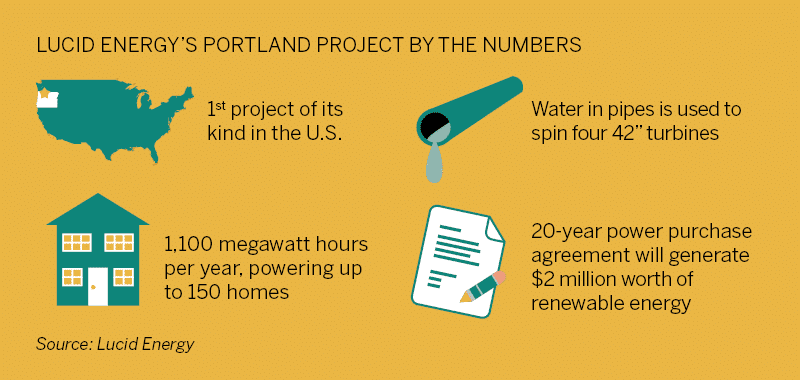A Real ‘Flow’ of Energy
November 24, 2015
Turbines generate electricity from water in city pipes
Entrepreneur Gregg Semler has been pitched some really good ideas. That’s how he knows what a home run looks like.
Semler heard about the idea of harvesting renewable energy from gravity-fed water pipes in a 2011 phone call. And for the last four years, he’s been at the helm of a company making microhydro energy systems a reality under streets nationwide.
Lucid Energy’s LucidPipe™ Power System enables industrial, municipal and agricultural facilities to produce clean, low-cost electricity from gravity-fed water pipelines and effluent streams.
“Hydropower isn’t new, but we haven’t seen anyone else who has a system that converts water in pipes to electricity the way we do it,” said Semler. “It’s really the first mass produced solution of its kind. Any pipe where water is running through it could be producing energy with this technology.”
With spherical turbines, often compared to egg beaters, the LucidPipe™ Power System harnesses the untapped energy potential of moving water inside any free-flowing water pipe.
“We are recapturing energy that already exists and would otherwise be lost,” said Semler.
The system is also not dependent on the weather, a detail setting the technology apart from other renewable energy sources.
“Water is the most important resource on the planet. But it’s also one of the most energy intensive.”
“It doesn’t rely on the sun shining or the wind blowing,” said Semler. “This electricity is reliable and consistent and can be used on-site or fed to the grid to reduce energy costs. Managers of water pipelines can dramatically decrease the costs of delivering safe, clean drinking water.”
That caught the attention of Portland, Oregon’s Water Bureau. Last January, the Rose City began generating electricity — enough to power 150 homes per year — in one of its largest drinking water pipelines. Lucid Energy has a 20-year agreement to sell the power generated by water rushing through the city pipe. A portion of that revenue will come back to the city to offset the cost of running its water system.
“Water is the most important resource on the planet,” said Semler. “But it’s also one of the most energy intensive. We’re demonstrating the economics of our system.”
Running the hot water faucet for five minutes uses about the same amount of energy as burning a 60-watt bulb for 14 hours, according to the Environmental Protection Agency.
The Portland project has given Lucid Energy a national soapbox. It is a proven, quintessential example of their technology at work. But Semler is already dreaming of going much further than home base. He says it’s time the world of water got a big upgrade.
“Over the last 25 years, the U.S. has invested billions of dollars to ensure reliability of our electrical grid,” said Semler. “The same is not true for water infrastructure. In many places, it’s 100 years old and breaking down. We need to rebuild water infrastructure in the U.S., and we would like to see the LucidPipe™ system play a pivotal role in rebuilding this infrastructure to improve the sustainability and economics of water.”
Lucid Energy now has its sights set on California, New York, Arizona and Texas — states where water prices are already high.
“The links between water and energy are resonating with people,” said Semler. “Saving one means saving the other.”

Featured image: LucidPipe™ Power System. The turbines have been compared to egg beaters. – Sherri Kaven
#electricity #freshwater Magazine Fall 2015 #hydropower #Lucid Energy #Oregon #Portland #Portland Water Bureau #renewable energy #resource #water pipes
